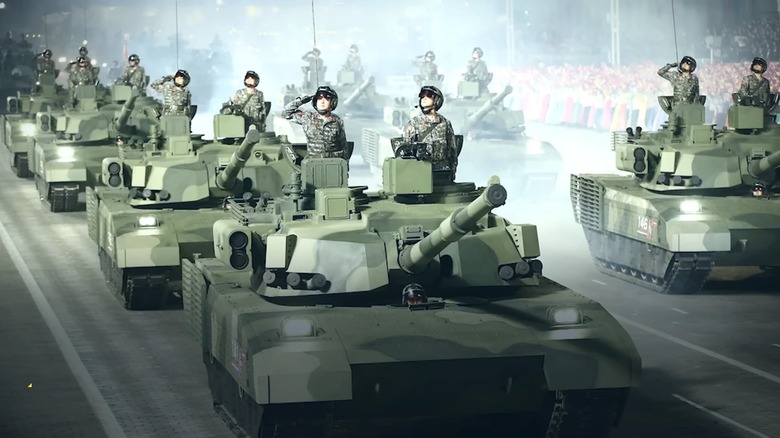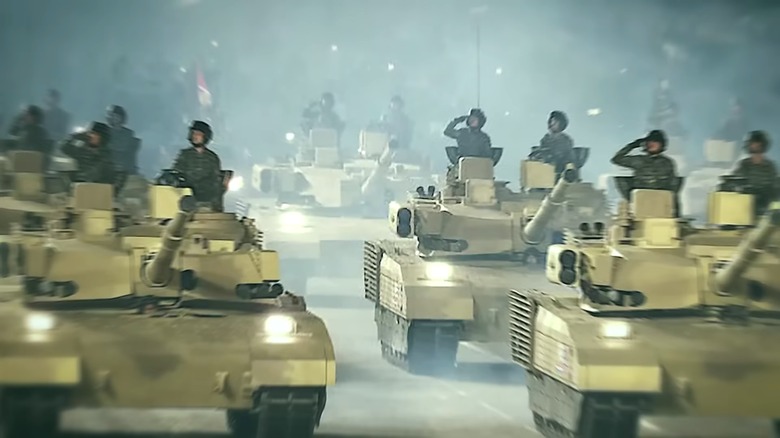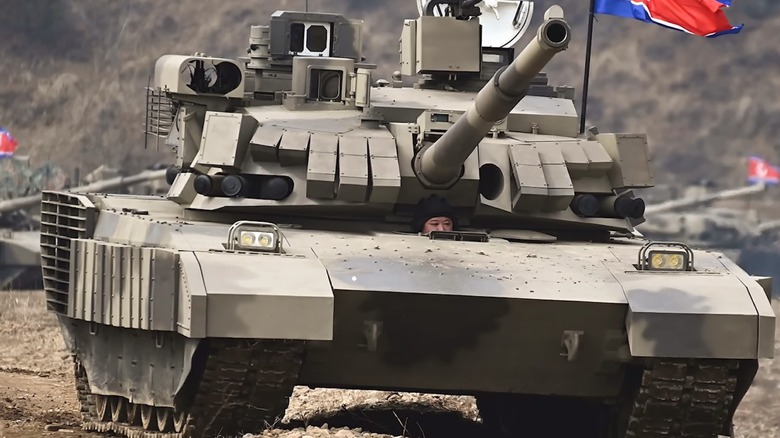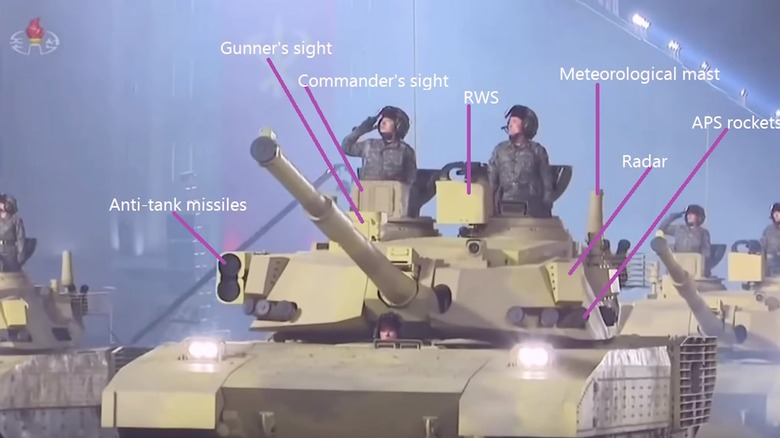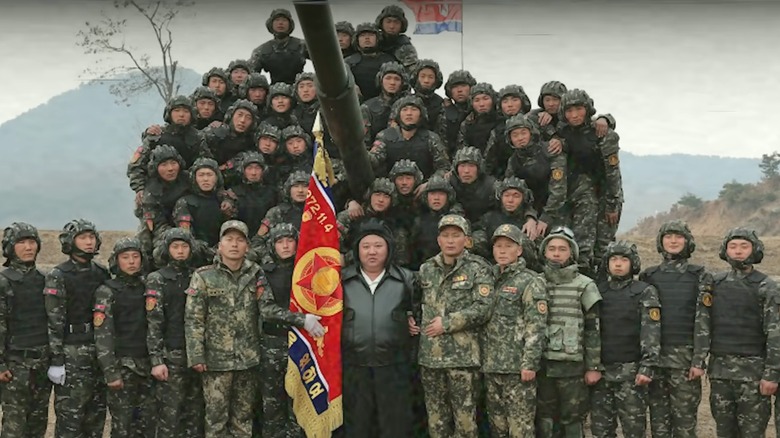Why North Korea's New M2020 Main Battle Tank Is Flashy Garbage
In October 2020, the Democratic People's Republic of Korea (North Korea) unveiled a new main battle tank at the 75th anniversary celebration of the founding of the Worker's Party of Korea. North Korea's new M2020 MBT is a garish upgrade from its prior designs, and from the look of it, its influence can be seen in everything from the M1A2 Abrams Tank to the Russian T-14 Armata. It also incorporates features from other tanks, but whatever its influences, the M2020 seems to be a beast.
The tank sports what appears to be an imitation of the Soviet 2A46 125mm gun found on other DPRK tanks, but that's not all. It also houses a coaxial machine gun, an AGS-30 grenade launcher, and two Bulsae-3 anti-tank missiles located to the right of the turret. The last armament is an unusual choice, as tanks (which have too many common misconceptions surrounding them) are designed to fire anti-tank rounds capable of destroying targets without relying on missiles. This is the first clue that the M2020 has more bark than it does bite.
In the past, the DPRK modified Soviet T-62s into amalgamated tanks of its own design. Production and maintenance limitations made designing tanks in-house challenging, which is why the M2020's appearance at the parade surprised so many onlookers. Kim Jong-un declared it one "of the most powerful tanks in the world," though this has yet to be seen as the M2020 has only appeared a few times in public, making analyzing them somewhat difficult (via National Interest).
What is the M2020?
First and foremost, M2020 is not the vehicle's designation — the DPRK hasn't revealed that information. Since its unveiling in 2020, the media dubbed it "M2020," and the name stuck. The M2020 is a new tank design, so it's not built from the chassis of a T-62, as most DPRK tanks are. This is evident in its seven-wheel track design. Additionally, the new tank incorporates offensive and defensive elements common to other nations' MBTs.
The media dubbed the M2020 "North Korea's Abrams" due to its similarities with the United States' MBT, but the comparison is only skin-deep. Specifications aren't widely known, but experts have analyzed footage and photos of M2020s since their introduction, and it's possible to draw some conclusions regarding the tank's armaments, armor, sensors, and more. One interesting fact is that the tank is only ever seen with three personnel.
This implies the existence of an autoloader for its gun, eliminating the need for a human loader. This is a step up from previous DPRK designs, potentially making the tank more useful in combat. This is speculation based on the scant footage the DPRK released, so a loader may be present inside the vehicle. Still, given the driver's location at the center of the tank just before the turret, it's likely the M2020 only requires three personnel to operate.
What are its defensive capabilities?
One of the main points of using tanks in combat is having an offensive vehicle that destroys targets while protecting its operators. This is the balance of any tank design — trading offensive capabilities for defensive ones and vice versa. The M2020 appears to employ a relatively uncompromising balance between the two, and its armor features several distinctive characteristics found on modern Russian and Western tanks.
The M2020 features what appears to be a composite armor around the tank's main body. Additionally, it features slat armor to protect the rear engine compartment and the rear of the turret. Rubber plates and skirts protect the seven road wheels. In terms of weight, it's possibly in the 50-ton range, making it lighter than the U.S. M1A2 Abrams MBT's 68 tons. The M2020 also sports what appears to be reactive armor as well as four hard kill active protection systems (APS), which could protect it from rocket-propelled grenades and similar munitions.
The DPRK demonstrated this in a short video, but only with an RPG, so it's unclear if the M2020's APS is capable of stopping a Sabot or high explosive anti-tank rounds from an opposing tank. Also, the video may not be as realistic as it appears, seeing as the DPRK is a propaganda-generating machine. Also, the placement of these is suspect, as they are cut into the turret, potentially weakening its armor.
What are its offensive capabilities?
The M2020 boasts numerous offensive capabilities. Its primary weapon is the aforementioned main gun, which can fire a variety of munitions. Additional armaments include a coaxial machine gun and an AGS-30 grenade launcher. While all of these are relatively standard tank weapons, the presence of two Bulsae-3 anti-tank missiles on the right side of the turret is unusual and likely only there for show.
The M2020 isn't the first tank to include such weaponry, but it's uncommon. The addition of a side-mounted missile launcher makes reloading difficult and dangerous and necessitates carrying multiple types of ammunition. This limits the already cramped space within a tank, so including the launcher is, in a word, odd. The missiles are more than capable of disabling or destroying armored targets, but again, that's what the main gun is for.
Several parts on the tank are likely mock-ups, seeing as the DPRK would have difficulty acquiring the parts necessary to install them. Because of this, it's likely the M2020s put on display by the DPRK are nothing more than that — a display of power meant to instill fear in North Korea's enemies. While the country may eventually bring the M2020 to combat and put it to the test, the nation doesn't have much experience in armored combat.
Should we be worried?
Very few people should be concerned about the existence of the M2020. All nine tanks sported desert camo when unveiled, which wouldn't help much on the Korean peninsula. This was eventually changed to a woodland pattern but demonstrated a clear misunderstanding of modern camouflage needs. The DPRK hasn't fought a tank battle since the early 1950s, and when it did, the U.S. and British armored forces wiped the floor with them. While the DPRK has retained an armor capability, it's untested, uses outdated and mismatched equipment, and is incomparable to modern armor.
The M2020 seemingly fixes this problem for the DPRK, but it's unlikely the tank is as operational as the country claims. The nation is well-known for its duplicity, so it's more likely the M2020 is a proof of concept or an ideal tank that may one day come to fruition. While its main components all likely function, the flashier bits, the active defense system, optics, and anti-tank missiles probably do not and are there for show.
Because of this, there's not much to fear from DPRK tanks, new and flashy or otherwise. Should the DPRK drive its armor south, they'd go up against the Republic of Korea and U.S. tanks and tankers, which benefit from more than 70 years of combat experience. Add to that the fact that U.S. and ally tanks aren't outfitted for propaganda, and it's unlikely the M2020 or other DPRK armor would last long because it's little more than flashy garbage.
